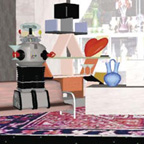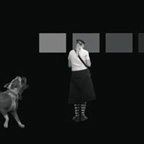
Under the Radar
Kill your television! Get ready for a totally wicked exhibition. Experimenta Under the Radar invites UK audiences to experience and interact with the high voltage works of Australia's best and most innovative media artists: 16 June - 28 August, 2006.
FACT, the Foundation for Art & Creative Technology is the UK's leading organisation for commissioning and presentation of film, video and new media art forms. FACT exists to inspire and promote the artistic significance of film, video and new and emerging media.
Includes:

ZiZi the Afffectionate Couch (2003) :: Stephen Barrass, Linda Davy & Kerry Richens: An invention inspired in equal parts by a shaved poodle, a fluffy Persian cat, and an exotic alien sea slug, ZiZi growls when sat on, purrs when touched, and emits soft groans of delight if you stroke her long fur. If left alone, ZiZi mews for attention. ZiZi is an affectionate ottoman couch that asks for emotional support while offering physical comfort. The responses are triggered by touch-sensitive cables, which are sewn into the fluffy upholstery of the couch. While Barrass claims that ZiZi's personality is based on his pet Dalmatian Ziggy, we can safely assume that the artist does not sit on his dog.

Op Shop (1999-2002) :: Stephen Barass: Cluttered from floor to ceiling with bric-a-brac, Op Shop is a virtual environment that is transformed by sound. Unlike most interactive interfaces where communication occurs by means of a stylus, mouse or other device, Op Shop encourages collaborative interaction. By singing into the microphone a visitor can disturb the virtual objects; a high-pitched wail can shatter glass. By singing and sustaining a low note, they can smash a table. An ever-changing choral score emerges as multiple participants explore the effects of their vocal range. This cacophony of hums, croons, shrieks, claps and whistles, punctuated by percussive shattering and laughter, propels the visitor towards an unexpected finale.

Dislocation (2005) :: Alex Davies: What happens when we can't trust what we see with our own eyes? As visitors peer into the portals of Dislocation, they become auto-voyeurs seeing and hearing unnerving scenarios play out behind them only to discover the room is empty when they turn around. Ingeniously programmed by Davies to overlay pre-recorded sequences with realtime footage, the simultaneous presence and absence of these phantoms defies rational thought and experience, and creates a haunting atmosphere. The work creates an environment of deception and uncertainty whose subtlety and cunning displaces our reliance upon, and trust of, our own distinct emotional responses to the presence of others.

